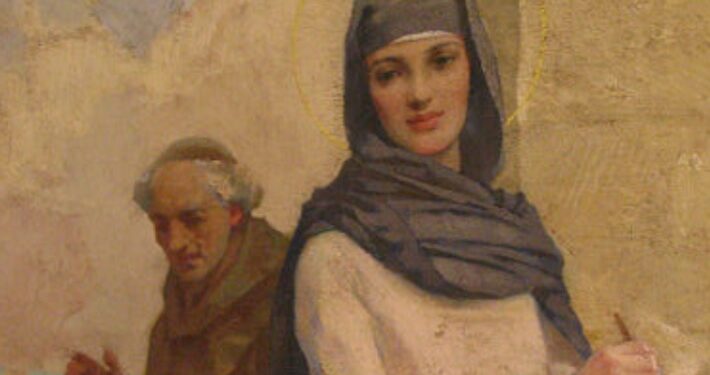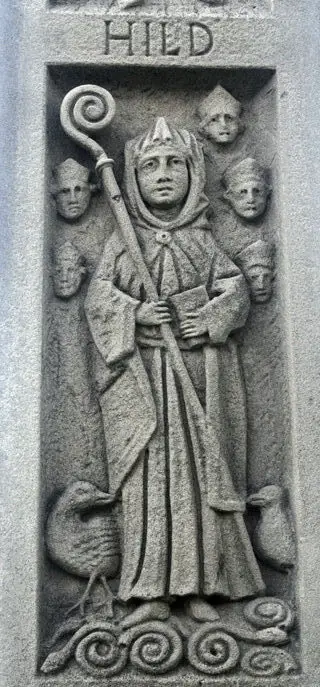St Hild of Whitby – History

By Vibeke Vasbo
Hild grew up in a pagan world, and was baptised in the year 627, aged 13, along with King Edwin of Northumbria. She became one of the most influential people of her time and contributed greatly to the conversion of Anglo-Saxons to Christianity.
We know her from the Venerable Bede’s Ecclesiastical History of the English People: she spent the first half of her life most nobly, and the second half even more nobly in the service of the Lord – which can be interpreted as Hild having married a pagan whom she did not succeed in converting. Bede prefers not to mention pagans, but his contemporaries probably even knew her children.
Hild wanted to join her sister as a nun in Chelles in Gaul, but Bishop Aidan of Lindisfarne asked her to assist him in converting the people of Northumbria. After a year living near the River Wear (Escomb or Wearmouth?), Hild entered the monastery of Hartlepool. She soon set up her own monastery in Whitby – a double monastery with nuns and monks, which was not unusual – and later another monastery in Hackness.
“Peace and charity”
Bede praises Hild for her wisdom: high and low sought her advice, and acted on it. King Oswine of Northumbria placed his infant daughter Ælfflæd in her care.
Bede’s admiration for Hild is remarkable, as he despised the Iro-Celtic Church to which she belonged. In the year 664, the dispute between this Church order and the Church in Rome was settled at the Synod of Whitby; the king decided that everyone had to submit to the Roman order. The independent leaders of monasteries had previously been in charge; power was now handed over to bishops, and then women had to be content with weaving and embroidery.
Hild’s monasteries stressed the necessity of justice, mercy, purity, and – above all – peace and charity. Studying the scriptures was important. Many items for writing and weaving have been excavated.
“Became a saint shorty after her death”
Hild supported Cædmon in creating songs in the traditional form and everyday language of the people, but with a Christian content – a powerful and innovative tool in the work of conversion. She became a saint shorty after her death, although lacking the common qualifications for sainthood: virginity, martyr’s death and miracles during her lifetime.
This is the skeleton of knowledge around which I built The Song of Hild. The flesh and blood had to be invented.
‘The Song of Hild’ by Vibeke Vasbo (pictured right), translated by Gaye Kynoch, is published by Sacristy Press, £12.99 paperback, ISBN: 9781910519868
Top image: Detail from ‘St. Hilda at Hartlepool’ by James Clark James (oil painting). Picture by Yaffa CC BY-SA 2.0, via Wikimedia Commons










